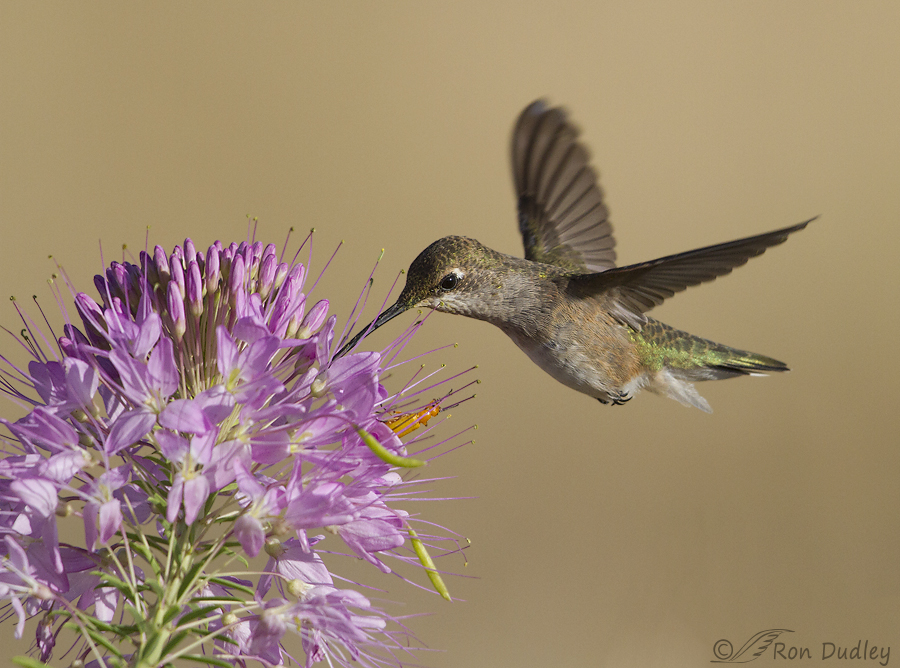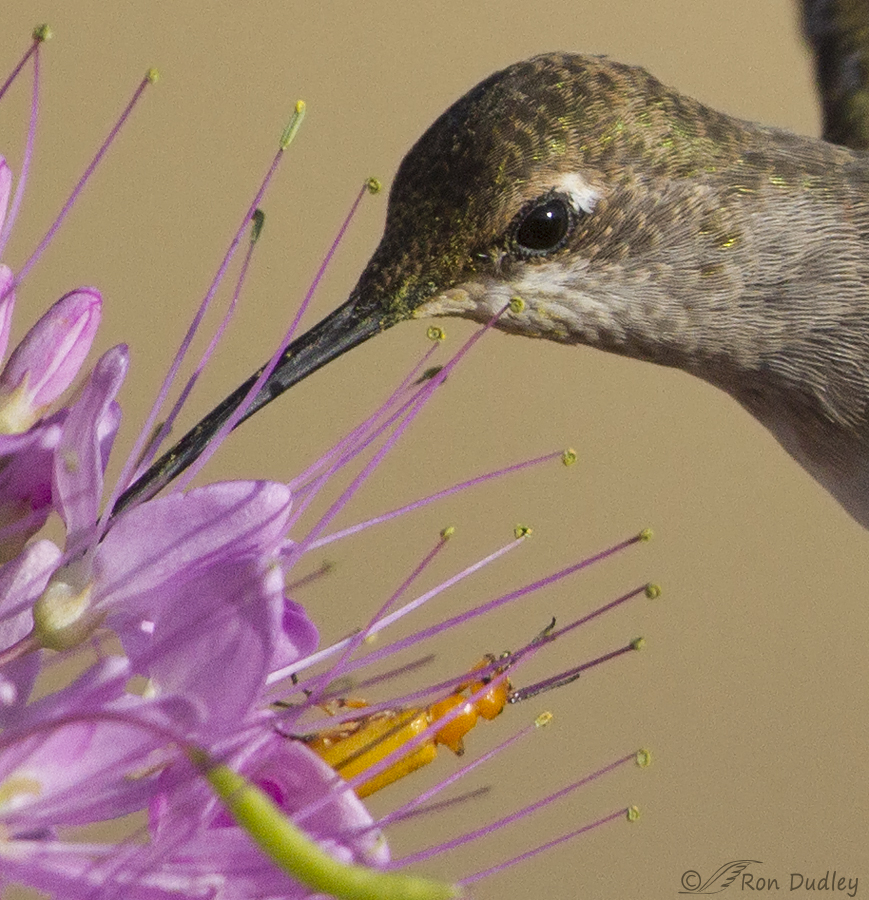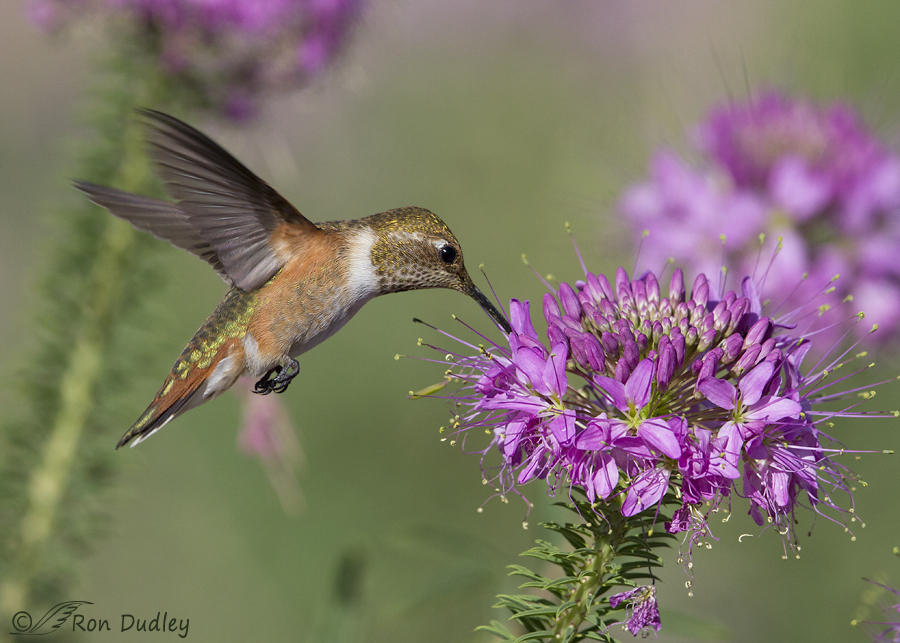Many photographers use elaborate setups and flash when photographing hummingbirds. I prefer au naturel.
Typically, flash has a harsh and unnatural look because it fills in the tiny shadows in fine detail (such as in feathers and flowers) and besides I just don’t have the heart to flash unsuspecting birds as they go about their business – to me doing so seems downright rude. Elaborate setups where attractive perches are placed in front of the camera and birds are lured to the perches by food and electronic calls seem more akin to studio photography than nature photography and it leaves me cold. All one has to do is google “bird photography setups” or “hummingbird photography setups” to see how pervasive the practice is. Some photographers make their living by teaching such techniques to dozens of others annually in paid workshops so the practice is spreading.
To each his own I guess but if I can’t photograph hummingbirds in a natural setting and without flash I won’t photograph them at all.

1/5000, f/5.6, ISO 640, Canon 7D, Canon EF500mm f/4L IS II USM +1.4 tc, natural light, not baited, set up or called in
My latest opportunity to photograph hummingbirds in a natural setting came this week on Antelope Island when I found several species of them (and sphinx moths) feeding on Rocky Mountain Bee Plant. This female Black-chinned Hummingbird (I think) was gorging herself on nectar as she flitted from flower cluster to flower cluster. One of the reasons folks use setups is to get clean backgrounds but as you can see it can also be done in a natural setting if you’re willing to work at it.
For me the yellow beetle in the flower was a serendipitous bonus rather than a distraction. I didn’t even see it until I put the image on the screen.

I’d really like to know the species of the beetle but considerable time spent researching it came up empty – it’s widely accepted that there may be over a million species of beetle so it’s not surprising that my efforts were fruitless. If anyone knows what kind of beetle it is I’d love to hear from you…

1/2000, f/8, ISO 640, Canon 7D, Canon EF500mm f/4L IS II USM +1.4 tc, natural light, not baited, set up or called in
Ok, back to hummers. This female Rufous Hummingbird was feeding on a different patch of bee plant two days ago. She was very protective of “her” patch and chased off other hummingbirds, bees, moths, butterflies and even a juvenile Loggerhead Shrike. She spent much of the rest of her time feeding – all that aggression requires lots of energy.
The background in this shot isn’t clean like it would likely be if the image was a setup but nature isn’t “perfect” so I just deal with it. Besides, everything behind the bird is out of focus and I don’t think it distracts much from the subject anyway, if at all. The colors in this image are pretty vivid but I’ve done nothing during processing to enhance them – all I did was crop, resize, selectively sharpen the bird and the flower and then add my copyright watermark.
Ron


I just checked out the link “Rocky” (AKA Susan Stone) provided…the photo of a Blister Beetle on that link looks just like the beautiful, bright yellow beetle in your photo…Well done, Detective Stone!
Beautiful work, great color and clarity!
Absolutely beautiful photos…I do NOT like “set up” Hummingbird photos at all. These are perfection…the background flowers in the Rufous photo add to the photo in my opinion!
Beautiful photos Ron. And I so admire your ethics regarding the photography of hummers.
My favorite bird, and in fabulous focus! Beautiful photos, Ron!
Thanks very much for all the comments and input, everyone. When I get a chance I’m going to use Dick’s link and send a photo to BugGuide and see what comes of it. I’ve been out shooting all morning and now have 1200 images to cull and then tomorrow’s post to do so I may not get to it immediately,
Thanks Ron. Another beautiful series. I do like starting my day here, smiling and oohing and ahhing.
My favorite feature is, in the first photo, the retracted landing gear look.
I dream of hummingbird photos as magnificent as yours. I try to take them in my garden but of course with not near the success as you.
The shape of this beetle is very familiar to me, and the thorax shape is one of the defining characteristics. I think it might be some kind of blister beetle, family Meloidae. Here is a link to one I was looking at that has the right shape and basic coloration: http://bugguide.net/node/view/237911/bgpage
I like your natural photos of hummingbirds. A ‘perfect’ background – whatever that is – would take away the context, and in my mind at least, context is an important part of seeing a bird. Nothing lives in a vacuum.
Susan, I’m thinking it might be one of the blister beetles too. I have some more research to do.
We have a very similar species of flower here in the east. I do not think it is Bee Balm here. I just can’t remember the name. Your photos are beautiful as always. I had no idea there were ‘lessons’ on how to set up a hummingbird shot. That is just strange to me. I take pictures of my few hummingbirds are all the time either when they are feeding at flowers or at one of my feeders. I actually really like blurred flowers in the background. Never bothers me. Getting the shot in focus is my main concern!!
Enchanting, Ron! I love the sheen on the feathers.
I meant to say second and third flowers in the background..I find that .three is a very pleasing number…and Iike odd numbers better than even in most cases…the resulting balance is great. Would make a really nice watercolor…there are some very beautiful, very interesting insects…glad you’re capturing a few, even if by accident…
Beautiful series…images 1,2,and 3 are my favorites…as a wildlife painter, the second is extremely helpful re: direction of growth and feather patterns, but love the angle in the first and the composition in the third…I find the soft hint of the second flower in the background very pleasing, enhancing the composition…maybe that’s my favorite.
I especially like the last one, Ron, I don’t find the flowers in the bokeh distracting at all. I was watching hummingbirds on my back deck yesterday and was amazed to see them actually chasing birds … tufted titmouse to be exact … away from the humming bird feeders, which close to the bird feeders!! Amazing little critters!!!!
I’m very fond of hummingbirds. Had one sit on my hand once.
Just sensational shots Ron! These little ones are extremely difficult to capture. Thanks so much for sharing!
Charlotte
Magnificent Photos Ron !
I can’t say what kind of beetle it is, except that it looks like many I have seen with different colors, however if you were to crop the beetle and send it to (BugGuide,http://bugguide.net/node/view/931900#1650209) they are the ones I use when in doubt or I need verification.
Great images as usual Ron, love the cropped one. Since we are seeing only the flowers, is this a plant that would grow in a garden in the east? Looks like a great butterfly and hummingbird attractant.
Rocky Mountain Bee Plant has been tamed, somewhat. In the garden, it is an annual called cleome and it grows well in Kentucky and Wisconsin.
Grows very well in Virginia, also.
And in Australia. And I will plant it again this year – regretting that it won’t attract hummingbirds.
Thanks very much, Dick. I’ll use the link later today. As far as I know RM Bee Plant isn’t found in the east but its close relative cleome does.
I have cleome growing in my garden now.